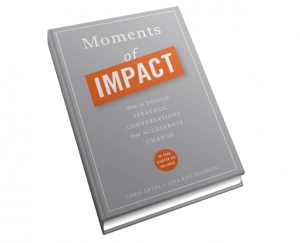Great strategic conversations generate breakthrough insights by combining the best ideas of people with different backgrounds and perspectives. They lift participants above the fray of daily concerns and narrow self-interest, reconnecting them to their greater, collective purpose. And they create deep, lasting impacts that propel organizations forward. Drawing on decades of experience as innovation strategists, Moments of Impact: How to Design Strategic Conversations That Accelerate Change unveils a simple, creative process that leaders and their teams can use to unlock solutions to their most vexing issues.
– From the Book’s Website
Next Week podcast guest Chris Ertel talks about his new book Moments of Impact: How to Design Strategic Conversations That Accelerate Change. Below is an introduction to the 5 steps on Designing a Great Strategic Conversation.
Excerpt from the Podcast:
Joe Dager: Well, yeah, in the book, you basically put out a nice pattern to follow and I think you have 5 different items to design one. Could you just briefly describe what those five are?
Chris Ertel: We have the five core principles that shape our process. The first is to define your purpose. Defining a purpose in a nutshell means having a very clear vision of what is the state of mind and the state of progress people are walking in the room with on the particular issue that you have. We’re having a clear vision of where you want them to land, where you want them to come out. And again, that’s not in terms of the specific outcome but the nature of the outcome, like we want them to be aligned about x, y, z and having a really clear vision on that.
Second is what we call ‘engage multiple perspectives.’ That’s the piece about, usually when we have differences, differences of opinion wherein either people are tamping it down, they’re ignoring their differences in order to get along or they’re in conflict over them, and we need to create an environment where people openly discuss their differences of opinions and emp loy them out in a productive way.
loy them out in a productive way.
Third is to frame the issues and that’s bringing one or two, not too many, but just a couple core frameworks in any conversation that enables system thinking, that enable people to connect the dots between different parts of the problem more readily.
Fourth is to set the scene and that’s thinking about all the elements of the environment. So, whether it’s the handouts that you used, the room that you used, everything needs to be congruent and create the kind of environment, the kind of emotional feeling effect that you want for this group to collaborate in a relaxed way.
Finally make it an experience means that to tap into not only people’s logical selves, but their emotional/psychological selves as well. Like the example I gave with the strategic alignment, with the executive group. They needed to have an experience of what it would feel like to deliver on this plan in the face of specific situations and that gets them to another level. So, those five things together, are what we do to design a strategic conversation.
Lean Sales and Marketing: Learn about using CAP-Do
Special Marketing with Lean Book and Program offers on Facebook
